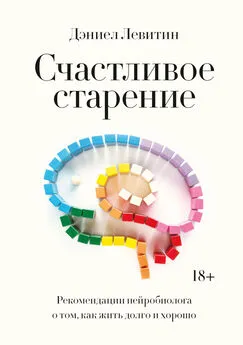Дэниел Левитин - Счастливое старение. Рекомендации нейробиолога о том, как жить долго и хорошо
- Название:Счастливое старение. Рекомендации нейробиолога о том, как жить долго и хорошо
- Автор:
- Жанр:
- Издательство:Манн, Иванов и Фербер
- Год:2021
- Город:Москва
- ISBN:9785001695868
- Рейтинг:
- Избранное:Добавить в избранное
-
Отзывы:
-
Ваша оценка:
Дэниел Левитин - Счастливое старение. Рекомендации нейробиолога о том, как жить долго и хорошо краткое содержание
Ответы на эти и многие другие вопросы вы найдете в книге известного нейробиолога и автора бестселлеров о природе возрастных изменений и о том, как можно прожить долго и что нужно делать сейчас (в любом возрасте), чтобы в 70, 80 и 90 жить полной жизнью.
Книга предназначена для широкого круга читателей.
На русском языке публикуется впервые.
Счастливое старение. Рекомендации нейробиолога о том, как жить долго и хорошо - читать онлайн бесплатно ознакомительный отрывок
Интервал:
Закладка:
278
D. G. Dutton and A. P. Aron, “Some Evidence for Heightened Sexual Attraction under Conditions of High Anxiety,” Journal of Personality and Social Psychology 30, no. 4 (1974): 510.
279
S. Schachter and J. Singer, “Cognitive, Social, and Physiological Determinants of Emotional State,” Psychological Review 69, no. 5 (1962): 379; G. L. White, S. Fishbein, and J. Rutsein, “Passionate Love and the Misattribution of Arousal,” Journal of Personality and Social Psychology 41, no. 1 (1981): 56.
280
Я уже писал об этом в статье: D. J. Levitin, “Brain Candy. Review of Human: The Science behind What Makes Us Unique, by M. Gazzaniga,” The New York Times Sunday Book Review, August 24, 2008, 5.
281
K. Jensen, J. Call, and M. Tomasello, “Chimpanzees Are Vengeful but Not Spiteful,” Proceedings of the National Academy of Sciences 104, no. 32 (2007): 13046–13050.
282
T. Lomas, “Towards a Positive Cross-Cultural Lexicography: Enriching Our Emotional Landscape through 216 ‘Untranslatable’ Words Pertaining to Well-Being,” Journal of Positive Psychology 11, no. 5 (2016): 546–558, http://dx.doi.org/10.1080/17439760.2015.1127993; T. Lomas, “The Magic of Untranslatable Words,” Scientific American, July 12, 2016, https://www.scientificamerican.com/article/the-magic-of-untranslatable-words/?print= true.
283
В целом синонимично русскому слову «злорадство». Прим. ред.
284
См. Фельдман Барретт Л. Как рождаются эмоции. Революция в понимании мозга и управлении эмоциями.М.: Манн, Иванов и Фербер, 2017.
285
L. F. Barrett, How Emotions Are Made: The Secret Life of the Brain (Boston: Houghton Mifflin Harcourt, 2017). ( Фельдман Барретт Л. Как рождаются эмоции. Революция в понимании мозга и управлении эмоциями.М.: Манн, Иванов и Фербер, 2017).
286
E. C. Nook et al., “The Nonlinear Development of Emotion Differentiation: Granular Emotional Experience Is Low in Adolescence,” Psychological Science 29, no. 8 (2018): 1346–1357.
287
Я уже писал об этом в статье: D. J. Levitin, “The Ultimate Brain Quest. Review of Connectome: How the Brain’s Wiring Makes Us Who We Are by Sebastian Seung,” The Wall Street Journal, February 4, 2012, C5–C6.
288
S. J. Lupien et al., “Beyond the Stress Concept: Allostatic Load – A Developmental Biological and Cognitive Perspective,” in Developmental Psychopathology, vol. 2, Developmental Neuroscience, ed. D. Cicchetti and D. J. Cohen, pp. 578–628 (Hoboken, NJ: John Wiley and Sons, 2015).
289
Онлайн-издание Оксфордского словаря, рубрика «stress», по состоянию на 25 февраля 2019 года: www.oed.com/view/Entry/191511.
290
P. Sterling, “Allostasis: A Model of Predictive Regulation,” Physiology and Behavior 106 (2012): 5–15; G. H. Ice and G. D. James, Measuring Stress in Humans: A Practical Guide for the Field (Cambridge: Cambridge University Press, 2007), p. 284.
291
P. Sterling and J. Eyer, “Allostasis: A New Paradigm to Explain Arousal Pathology,” in Handbook of Life Stress, Cognition and Health, ed. S. Fisher and J. Reason, pp. 629–649 (Oxford, UK: John Wiley and Sons, 1988).
292
Благодарю Соню Люпьен за помощь в написании предыдущих двух абзацев.
293
A. Edes and D. E. Crews, “Allostatic Load and Biological Anthropology,” American Journal of Physical Anthropology 162 (2017): 44–70.
294
H. Frumkin et al., “Nature Contact and Human Health: A Research Agenda,” Environmental Health Perspectives 125, no. 7 (2017): 075001; C. E. Hostinar and M. R. Gunnar, “Social Support Can Buffer against Stress and Shape Brain Activity,” AJOB Neuroscience 6, no. 3 (2015): 34–42; A. Linnemann et al., “Music Listening as a Means of Stress Reduction in Daily Life,” Psychoneuroendocrinology 60 (2015): 82–90.
295
A. Danese and B. S. McEwen, “Adverse Childhood Experiences, Allostasis, Allostatic Load, and Age-Related Disease,” Physiology and Behavior 106, no. 1 (2012): 29–39; B. S. McEwen, “Allostasis and Allostatic Load: Implications for Neuropsychopharmacology,” Neuropsychopharmacology 22, no. 2 (2000): 108–124.
296
D. J. Barker, “Developmental Origins of Chronic Disease,” Public Health 126, no. 3 (2012): 185–189.
297
T. Booth et al., “Association of Allostatic Load with Brain Structure and Cognitive Ability in Later Life,” Neurobiology of Aging 36 (2015): 1390–1399.
298
G. Bizik et al., “Allostatic Load as a Tool for Monitoring Physiological Dysregulations and Comorbidities in Patients with Severe Mental Illnesses,” Harvard Review of Psychiatry 21 (2012): 296–313; R. W. Kobrosly et al., “Depressive Symptoms Are Associated with Allostatic Load among Community-Dwelling Older Adults,” Physiology and Behavior 123 (2014): 223–230; J. A. Stewart, “The Detrimental Effects of Allostasis: Allostatic Load as a Measure of Cumulative Stress,” Journal of Physiological Anthropology 25 (2006): 133–145.
299
E. Zsoldos et al., “Allostatic Load as a Predictor of Grey Matter Volume and White Matter Integrity in Old Age: The Whitehall II MRI Study,” Scientific Reports 8, no. 1 (2018): 6411.
300
R. P. Juster and B. S. McEwen, “Sleep and Chronic Stress: New Directions for Allostatic Load Research,” Sleep Medicine 16, no. 1 (2015): 7–8.
301
B. L. Ganzel, P. A. Morris, and E. Wethington, “Allostasis and the Human Brain: Integrating Models of Stress from the Social and Life Sciences,” Psychological Review 117, no. 1 (2010): 134; B. S. McEwen and P. J. Gianaros, “Stress-and Allostasis-Induced Brain Plasticity,” Annual Review of Medicine 62 (2011): 431–445; G. Tabibnia and D. Radecki, “Resilience Training That Can Change the Brain,” Consulting Psychology Journal: Practice and Research 70, no. 1 (2018): 59–88.
302
G. Y. Lim et al., “Prevalence of Depression in the Community from 3 ℃ountries between 1994 and 2014,” Scientific Reports 8, no. 1 (2018): 2861; J. Wang et al., “Prevalence of Depression and Depressive Symptoms among Outpatients: A Systematic Review and Meta-analysis,” BMJ Open 7, no. 8 (2017): e017173, http://dx.doi.org/10.1136/BMJopen-2017-017173; D. J. Brody, L. A. Pratt, and J. P. Hughes, “Prevalence of Depression among Adults Aged 20 and Over: United States, 2013–2016” (Hyattsville, MD: NCHS Data Brief 303, National Center for Health Statistics, 2018), pp. 1–8.
303
Institute for Quality and Efficiency in Health Care, “Depression: How Effective Are Antidepressants?” Informed Health Online, updated January 12, 2017, https://www.ncbi.nlm.nih.gov/books/NBK361016/; A. Cipriani et al., “Antidepressants Might Work for People with Major Depression: Where Do We Go from Here?” Lancet Psychiatry 5, no. 6 (2018): 461–463.
304
Из личного общения с Его Святейшеством Далай-ламой, Дхарамсала (Индия), 30 августа 2018 года.
305
“Dalai Lama: ‘Anger, hatred, fear, is very bad for our health,’ ” posted by CBS News, October 2013, https://www.dailymotion.com/video/x16a709.
306
“No Regrets: Dalai Lama’s Advice for Living and Dying,” posted by Karuna Hospice Service, August 6, 2015, https://www.youtube.com/watch?v=k3eJ4ezYXDI.
307
Centers for Disease Control and Prevention, “Depression Is Not a Normal Part of Growing Older,” https://www.cdc.gov/aging/mentalhealth/depression.htm.
308
U. Padayachey, S. Ramlall, and J. Chipps, “Depression in Older Adults: Prevalence and Risk Factors in a Primary Health Care Sample,” South African Family Practice 59, no. 2 (2017): 61–66.
309
A. Fiske, J. L. Wetherell, and M. Gatz, “Depression in Older Adults,” Annual Review of Clinical Psychology 5 (2009): 363–389.
310
K. L. Lichstein et al., “Insomnia in the Elderly,” Sleep Medicine Clinics 1, no. 2 (2006): 221–229.
311
H. C. Hendrie et al., “The NIH Cognitive and Emotional Health Project: Report of the Critical Evaluation Study Committee,” Alzheimer’s and Dementia 2, no. 1 (2006): 12–32.
312
R. J. Davidson et al., “Neural and Behavioral Substrates of Mood and Mood Regulation,” Biological Psychiatry 52, no. 6 (2002): 478–502; G. Gariepy, H. Honkaniemi, and A. Quesnel-Vallee, “Social Support and Protection from Depression: Systematic Review of Current Findings in Western Countries,” British Journal of Psychiatry 209, no. 4 (2016): 284–293.
313
Из личного общения с Джеффрри Могилом 16 июля 2019 года.
314
Selective Serotonin Reuptake Inhibitors – селективные ингибиторы обратного захвата серотонина. Прим. ред.
315
J. Rodda, Z. Walker, and J. Carter, “Depression in Older Adults,” British Medical Journal 343, no. 8 (2011): d5219.
316
H. Lavretsky et al., “Combined Citalopram and Methylphenidate Improved Treatment Response Compared to Either Drug Alone in Geriatric Depression: A Randomized Double-Blind, Placebo-Controlled Trial,” American Journal of Psychiatry 172, no. 6 (2015): 561; T. A. Ketter et al., “Long-Term Safety and Efficacy of Armodafinil in Bipolar Depression: A 6-Month Open-Label Extension Study,” Journal of Affective Disorders 197 (2016): 51–57.
317
K. N. Månsson et al., “Neuroplasticity in Response to Cognitive Behavior Therapy for Social Anxiety Disorder,” Translational Psychiatry 6, no. 2 (2016): e727; D. Collerton, “Psychotherapy and Brain Plasticity,” Frontiers in Psychology 4 (2013): 548.
318
R. D. Lane et al., “Memory Reconsolidation, Emotional Arousal, and the Process of Change in Psychotherapy: New Insights from Brain Science,” Behavioral and Brain Sciences 38 (2015).
319
R. J. DeRubeis, G. J. Siegle, and S. D. Hollon, “Cognitive Therapy versus Medication for Depression: Treatment Outcomes and Neural Mechanisms,” Nature Reviews Neuroscience 9, no. 10 (2008): 788.
320
Davidson et al., “Neural and Behavioral Substrates.”
321
W. H. Frey II, Crying: The Mystery of Tears (Minneapolis, MN: Winston Press, 1985); R. Turner et al., “Effects of Emotion on Oxytocin, Prolactin, and ACTH in Women,” Stress 5, no. 4 (2002): 269–276.
Читать дальшеИнтервал:
Закладка:








![Дэниел Левитин - Путеводитель по лжи [Критическое мышление в эпоху постправды]](/books/1101191/deniel-levitin-putevoditel-po-lzhi-kriticheskoe-my.webp)

